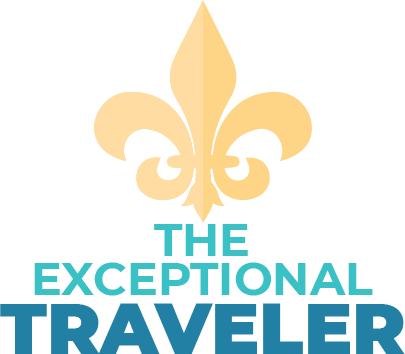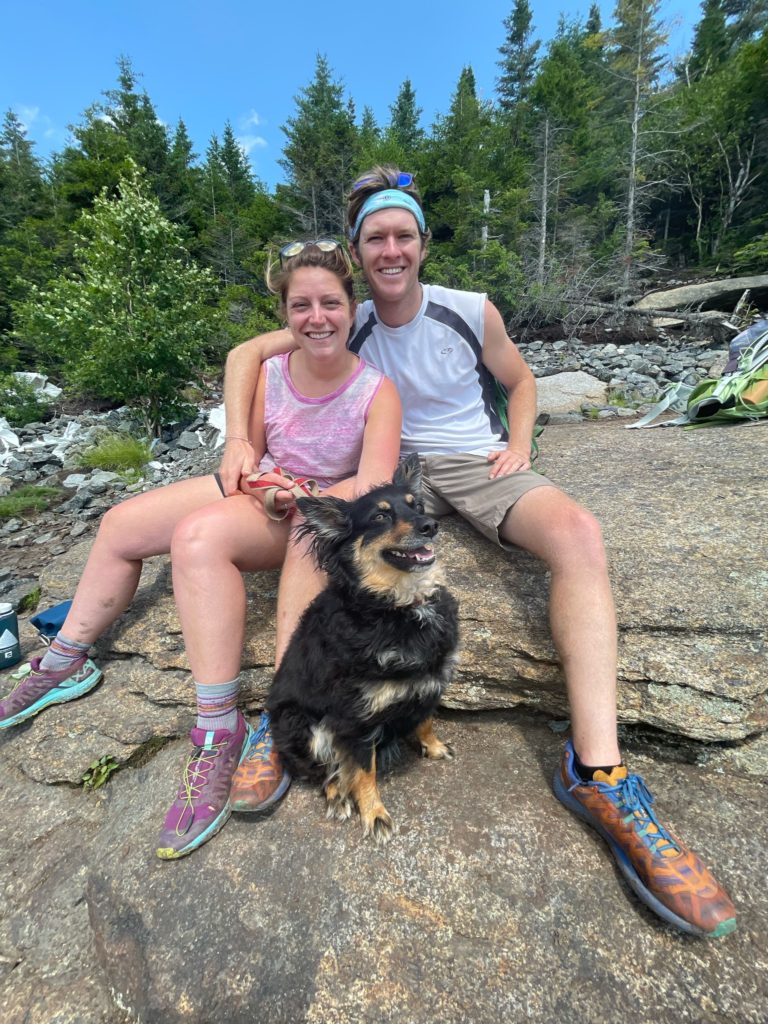Have you ever dreamed about taking the classic journey to look for America, winding through national parks, big cities and small towns. If this is the summer to finally hit the road and escape from the craziness of the rest of the world, now is the time to start planning.
Last summer, two of our Exceptional Travelers did just that. Anastassia and Alex were nice enough to recap their trip for us, including how they planned their route. They are both teachers, so they had the whole summer to wander around the country. Here’s their report, along with tips that apply to any road trip, big or small.
What We Did On Our Summer Vacation. . .By Anastassia & Alex
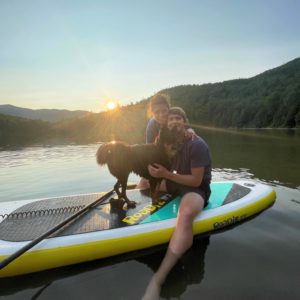
Three Paddleboarding Pups at sunrise on Heart Lake in New York’s Adirondacks
The classic question that teachers like us ask on the first day of school is “What did you do on your summer vacation?”. There’s something paralyzing about that question – almost as if it’s too much and too little all at once. Before we put our students on the spot to answer this question, my husband, Alex and I thought we should give it a go ourselves. What did we do this summer? To put it mildly, we made the most of it! As two teachers who had a long year (who didn’t?!), we said no to working summer camp for the first time in our teaching careers and said yes to a six week cross-country road trip. We had some clear goals: to see friends and family that we hadn’t seen in many months due to the coronavirus pandemic and to get our bodies, brains, and hearts outdoors to explore our big nation.
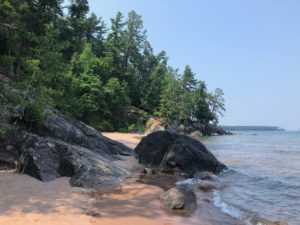
Hidden Beach, near Marquette, in Michigan’s Upper Peninsula
We started planning in April with a large map of the United States for reference, a big blank piece of chart paper for drawing our route, two computers – one to pull up Google Maps and one to look up campsites and hotels. We also had our contact list of friends and family that we wanted to see. The original route we mapped out on that first day of trip planning turned out to be pretty similar to the route we used from June to August, 2021, except we traded a return through the Rocky Mountains for a Southwestern detour. Our starting and ending point was clear, as we live in San Francisco, and we knew we wanted to make it to Cleveland to visit my family and to Glens Falls, NY to visit Alex’s family. How we would get there weirdly fell into place quite easily as we started plotting out where close friends and members of our extended family live and tried to keep driving times to a maximum of nine hours. Close friends are why Eugene, OR, Twisp, WA, Burlington, VT, Keene, NY, Philadelphia, PA, Culpeper, VA, and Sweetwater, TN were quickly added to the map. Extended family is how both Rochesters (MN and NY) and Wolfeboro, NH ended up on the route.
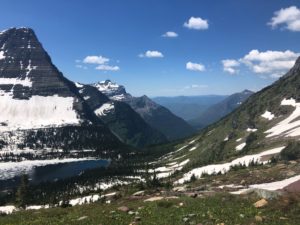
The view from our hike along the Continental Divide in Glacier National Park, Montana
Once these places were roughly placed on the big chart paper, we found that there were two big gaps in the route that were up in the air – how we would get from eastern Washington to Minnesota heading east and how we would get from eastern Tennessee back to San Francisco on the way home. This is where the adventure daydreaming came into play the most, as we Google Mapped many different trip options that would take us through different national parks and forests, interesting cities, and great mountain biking and hiking spots we had only read about. Some stops were added by both of us for hiking and wildlife viewing, like the Columbia River Gorge, Glacier National Park, and the Black Hills, while others were focused on one of our interests, such as mountain biking in the Ozarks of Northwest Arkansas for Alex and visiting Meow Wolf (Google it, trust me) in Santa Fe for me. We kept enough flexibility in our schedule to allow for last minute additions, like when we decided to stop at Mount Rushmore two days before getting to the Black Hills when we realized that our campsite at Sheridan Lake was only 20 minutes from the historic landmark. Up until the week before we left San Francisco, we thought we would stay in Flagstaff, AZ on the way back but then switched our plans to camp in the Grand Canyon. It added several hours of driving to the trip, but was an easy decision once we found that there were many campsites available in the Grand Canyon and that Flagstaff’s hotels were very expensive.
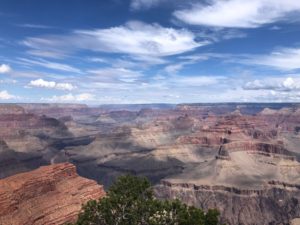
Hiking along the South Rim of the Grand Canyon
If you’re considering a long road trip like us, the two biggest expenses you can control are how much you’ll spend on lodging and food (more on food in our tips section below). You can’t control how much gas costs (though you can buy a hybrid or electric vehicle) and you can’t avoid toll roads altogether, so don’t even bother to try. But where you stay and how you eat are definitely two things that can add up fast. We are lucky to have friends and family scattered around the United States, so we spent 26 nights on our trip crashing with loved ones. We spent another nine nights camping and stayed in motels or rentals for the remaining nine nights. The distribution of camping versus motels or rentals was determined first by natural beauty and then by driving distance. I quickly made a rule that we would not camp if the driving day was longer than eight hours, since we always run late and setting up a campsite in the dark while trying to cook dinner on a camping stove and find the dog’s food bowl buried in the trunk is no fun. That’s why we stayed in motels in Great Falls, MT and Santa Fe, NM. We tried to intersperse a motel or friend and family stay for every three camping days so that we could shower (a great idea) and restock on supplies. Since we brought our dog Poncho on the trip, we also booked rentals if we knew it would be very hot and humid at our destination, such as in Fayetteville, AR, so that Poncho wouldn’t get roasted. In general, we found hotels and motels to be much more dog-friendly and flexible on cancellations or adjustments to reservations than rental sites such as AirBnb or VRBO.
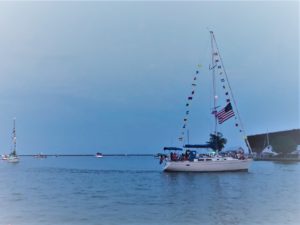
Celebrating the Fourth of July at the Marquette Boat Parade in Michigan
There are many ways to run the numbers on our trip. There are the logistics details – 25 states visited via 9,000 miles driven over 140 hours of driving time during the course of 45 days. There’s the personal highlights of sights we saw that we can easily quantify – time spent in five national parks, visiting all of our family members in the United States (except for two aunts and one uncle), and crashing with 15 close friends over the course of the trip. And then there’s so much more, comprised of small moments from the trip which are random, silly, funny, sad, private, exciting, and absolutely unforgettable. There were the hysterical mountain goats shedding their winter coats in Montana; the magnificent bull elk in Navajo Nation in Arizona; and the tiny wood frogs in the Adirondacks. We cooked dinner and played games with four sets of friends who had moved and purchased new homes during the pandemic that we had never visited. We watched fireworks and did crosswords with my mother and held my sister’s hand as she conquered her fear of heights on a hike. We set up an online shop for my mother-in-law’s quilting business and celebrated my sister-in-law’s bridal shower. We took Poncho out on a paddle board to great success and a whole lot of shrieking and giggling. We shared both tears and laughter with family members and friends as we tried to talk about where we will one day move if we leave California and what we want to do next. We saw two sets of friends imminently expecting their first children, and stayed up way too late over several campfires discussing our own difficult quest to get pregnant along with our hopes for the future. We swam in every body of water imaginable – from the Willamette River in Oregon, Flathead Lake and Lake McDonald in Montana and Sheridan Lake in South Dakota to the Michigan shores of Lake Superior, the Ausable River and Heart Lake in the Adirondacks, Lake Wentworth in New Hampshire and Ute Lake back out west in New Mexico. Having lived in dry California for almost a decade, we took full advantage of clean (sometimes glacially cold!) water throughout the trip and appreciate how sacred this resource is. We fell in love with Missoula, MT over delicious tacos and a sunset at 10pm (!) and we slept in our childhood bedrooms as adults. My husband and I talked and listened to each other. A lot. And we absolutely loved it. See you next summer, Utah, Colorado, and Idaho.
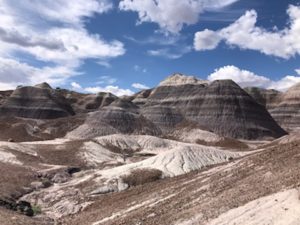
A much hotter hike in Petrified Forest National Park in Arizona
Some tips and advice (in no particular order):
- Get into Broadway musicals and/or podcasts – The radio can only take you so far, and 140 hours of driving time are a lot to fill with “Is this station country or Jesus radio?”. We highly recommend In the Heights, Book of Mormon, and Guys and Dolls. For the more podcast-inclined, check out Broken Record, 99% Invisible and How to Save a Planet.
- Don’t plan on making too many phone calls on the road – Cellphone service is not very strong throughout much of our country outside of large metropolitan areas (which surprised us but probably shouldn’t have) and you’ll end up with a lot of slightly frustrated family members telling you to try them again tomorrow.
- Get a nice cooler and use it well to save money on groceries – We purchased a 52 quart RTIC cooler and tried to keep the following supplies on hand: milk for coffee, yogurt and berries for breakfasts, sandwich meat and cheese and a fun spread for lunches, and some wine. During some of our fancier camping nights, we got sausages or steaks to grill on our cast-iron skillet (great for camping!). We also stocked up on Patagonia Provisions camping meals, such as smoked salmon, black bean soup, and green lentil stew, so that we didn’t have to keep all our dinner food in the cooler as space could get tight in there. We tried to keep salad greens and more fruit on hand but it easily got squished on the road, so we recommend getting a basket for your cooler if it doesn’t come with one so that you can keep such items away from bottles or tubs. The trick to this, however, is being diligent about restocking your cooler with ice every couple days so food doesn’t go bad just when you need it. A nice cooler is also an excellent canvas for sticker souvenirs (see next tip).
![]()
![]()
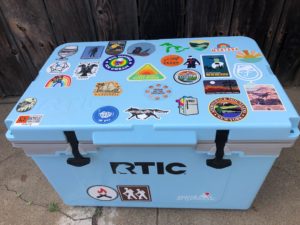
- Pick one type of souvenir or physical artifact you want to gather from the places you visit, and do it – We chose to purchase stickers from many states, parks and cities we visited and used them to spice up our cooler. Stickers are relatively cheap, can be purchased from local vendors and artists, and don’t require a big time commitment to find. National parks, in particular, have truly beautiful branding and feature prominently on our cooler. Now that we are back at work in San Francisco, every time I walk by the cooler in the garage while doing laundry or taking out the trash, I get a flash of a wonderful summer memory when I see those stickers. They also make for great storytelling every time you use the cooler after the trip!
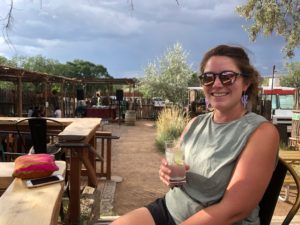
Enjoying cocktails at a distillery in Santa Fe, New Mexico
- Cook meals with the people you visit on the road – It’s so easy to start going out to dinner or drinks with every person you visit. We had a blast at different breweries and restaurants on the road, but there is nothing more normal and more intimate than cooking a meal with friends and family you haven’t seen in a long time. You re-learn, or perhaps discover, so much about the people you love, from how they organize their spice rack and their thoughts on famous chefs to which herbs they grow at home or how they’ve cut meat from their diet to combat climate impacts. From homemade pizza with friends in Burlington, salmon and potatoes in Glens Falls, and pulled pork and coleslaw in Twisp, to cheese and vegetable plates alongside wine in Cleveland, these are meals we won’t soon forget.
- Don’t pack the car too much. . .you need less than you think – If you’re on the road for weeks, you want room to stretch your feet, buy a piece of art or be able to reach the shoe bag without unloading four other bags every time. One important exception we made to this “pack light” mantra was to bring two nice pillows. Knowing we would be camping multiple times and probably napping in the car on long driving days, getting good rest was worth jamming real-sized pillows on top of the cooler and next to the dog.
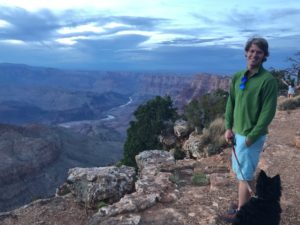
Our first sunset in the Grand Canyon, with the Colorado River far, far below
- Don’t get scared away from visiting national parks, but do plan ahead – So often, we heard from the internet and news sources that the national parks would be crowded, overused, and not the same as before. I am sure that this is indeed true in some places, but I hate that we almost skirted around some of the national parks for fear that we would find ourselves crowded in some kind of outdoor Disneyland. Maybe we got lucky with the days we visited, but we had a truly amazing time visiting Glacier, the Badlands, Shenandoah, Petrified Forest, and the Grand Canyon National Parks. We also spent time camping and hiking in the Black Hills, the Ozarks, and the Adirondacks, which are not national parks but easily could be. Our tip is to dig deeper than the headlines and get out in our parks on foot if you can. Visitor centers are crowded, but the trails have space for everyone. Get some great snacks, bring water, wear good shoes, and if you physically can, explore these natural wonders on foot. If the national park campgrounds or lodging areas are full, we recommend exploring national forests and state parks. They are often strikingly beautiful, more dog-friendly, and have more options for those like us who don’t or can’t plan many months in advance.
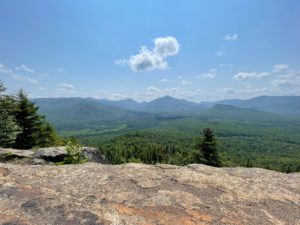
The High Peaks of the Adirondack Mountains in New York State
- Embrace camping. . .if you can – You don’t have to be a big backpacker to love camping. Figure out what will make car camping comfortable for you (A real pillow? A tent you can stand up in? A blow up mattress? Good wine?) and try it out. If you don’t want to invest in a full camping set up, don’t know what to buy, or can’t afford the whole shebang, we recommend finding an outdoor gear store that does tent, sleeping bag, and other gear rentals. We love Sports Basement in California and REI around the country, but I am sure that there are many other local stores. Camping is the best way to get more intimate moments in the wilderness: You are the first and the last person to experience the park each day. One of the most magical moments we had on the whole trip was watching the sunset over the Grand Canyon and then walking five minutes back to our site at Desert View campground, right off the canyon rim, and toasting the day with a glass of wine while cooking dinner on our little camp stove.
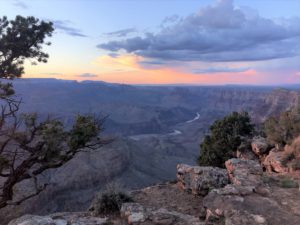
Sunset all along the Watchtower in the Grand Canyon
Ready to go? Let us know if you’re planning a road trip this summer. . .whether it’s thousands of miles or a few hundred miles closer to home. If you have questions, ask away; we have a really good resource for you! A million thanks to Anastassia and Alex for sharing their American journey with us. Also, a great post-script. . .they’re pregnant and due in August! Good thing they made the big trip last year.
